|
---

---

---


Buy RYA Sea Survival
Handbook at the RYA Shop

Buy RYA Boat Safety
Handbook at the RYA Shop

Buy RYA Day Skipper
Handbook at the RYA Shop

Buy RYA Sail Cruising
Logbook at the RYA Shop
 |
Man-Over-Board (MOB)
RYA Day Skipper, Coastal Skipper & Yachtmaster™ Man-Over-Board drill for sail cruising.
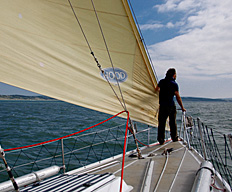
It’s also good to know that if one of your crew fell overboard you would know what to do: you need a plan.
|
Ultimately the reason we go boating is to have fun; enjoying the freedom and exhilaration that getting out on the water provides is always the bottom line.
As with any sport, however, sailing is not without its risks. It doesn’t pay to dwell too much on these things otherwise, frankly, you’d never get out of bed. Once in a while though, it pays to be prepared.
And this brings us on to man overboard: It’s not really a subject you want to ponder as you step aboard your boat for a day’s sailing. On the other hand, in the highly unlikely event of finding yourself in the water with your boat sailing away, it would be nice to think your crew could rescue you.
|
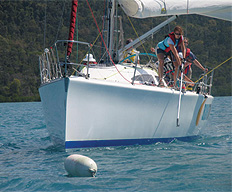
The man overboard (or fender in this case) should be to leeward as you approach |
Brief Your Crew
Sailing isn’t a hugely dangerous sport, and you don’t want to scare your crew, but it pays to discuss Man Overboard. If you have a regular drill in place, then you could buy yourself valuable time should the unthinkable ever happen.
This is the accepted RYA Yachtmaster™ crew drill in the event of a Man Overboard:
- - Shout ‘man overboard’ to alert the crew.
- - Press the MOB button on the GPS.
- - Throw a life buoy and dan buoy to the MOB. Mark the MOB with a smoke-flare
- - Allocate a crewmember to point at the MOB in the water.
- - Send a DSC distress alert and a Mayday.
- - Keep pointing; don’t lose sight of the MOB.
- - If the motor has been started,
- - Prepare a throwing line.
- - The skipper will bring the boat alongside the MOB, with the boat pointing into the wind and the propeller stopped.
- - Get a line around the MOB and get them aboard.
|
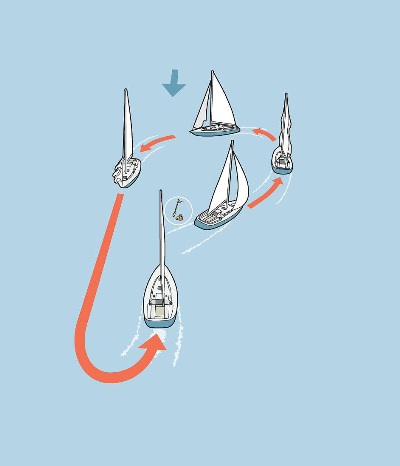
|
Man Overboard Manoeuvres
So that’s the crew briefed, now comes the tricky bit: actually pulling off the manoeuvre. A good method of practicing is by throwing a fender overboard weighted down with a bucket or a coil of rope. Just make sure the crew don’t lose sight of the fender!
Under Power
If you’ve got a motor, and it works, you’re going to want to use it in an emergency, so let’s deal with that scenario first:
- Sheet in the mainsail and heave to in order to take the way off your boat pass buoyancy to the casualty and mark with a dan buoy. Instruct a crewmember to point at the MOB. Retrieve any warps from the water and start the engine.
- Furl or drop the headsail.
- Make ready the throwing line.
- Manoeuvre the boat downwind of the MOB, keeping the MOB in sight.
- Approach the MOB into the wind, so that the mainsail is depowered. Pick up the MOB on the leeward side, aft of the mast.
|
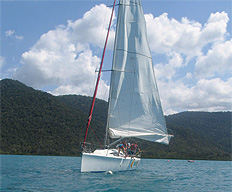
On a close reach you can spill and fill your mainsail to control your speed |
Man Overboard Manoeuvres
So that’s the crew briefed, now comes the tricky bit: actually pulling off the manoeuvre. A good method of practicing is by throwing a fender overboard weighted down with a bucket or a coil of rope. Just make sure the crew don’t lose sight of the fender!
Under Sail
Now comes the really tricky bit! There’s a definite art to coaxing your boat gently into the breeze and coming to a standstill alongside your target. Getting it right is a great feeling.
Even if you weren’t concerned about safety, it’s a trick that’s well worth mastering and the fact is that a man overboard situation is EXACTLY the time when your motor will decide not to start, so it’s in your interests to get this one nailed down.
|
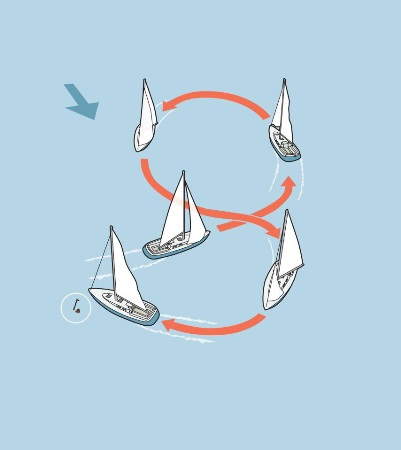
|
-
Turn away onto a beam/broad reach and sail away.
-
Sail away for about five or six boat lengths, ensuring that you do not lose sight of the MOB.
-
-
Tack, aiming the leeward side of the yacht at the MOB. Let out the headsail and mainsail sheets. The mainsail should flap; if not, bear off downwind to change the angle of approach. Point the boat back at the MOB until the mainsail flaps.
-
The angle of approach should be a close reach so that the sails can be powered and depowered. Drop the headsail if there from the mainsail alone.
-
Fill and spill the mainsail and slowly approach the MOB. Pick up the MOB to leeward, aft of the mast.
|

The final sticking point is recovery: if your boat has any kind of freeboard at all, you’ll soon realise that trying to get them out of the water is not as simple as it looks. |
Man Overboard Recovery
If your boat has a bathing platform on the transom, then you might be able to get them back aboard via the ladder. It is worth bearing in mind that in rough conditions this will be a dangerous place to attempt to recover a MOB, as there is a risk of being drawn under the stern.
Parbuckle
This is set on the side of the boat with the foot attached to the gunwale. The head is attached either to a handybilly (block and tackle) or straight to the halyard.
MOB Recovery Raft
These are purpose built for the job. Again, you could use the halyard or, if your boat doesn’t have a solid kicker, the boom and mainsheet.
Excerpts taken from Keith Colwell’s RYA Sea Survival Handbook. To find out more about safety at sea, you can pick up a copy by going to the RYA Web Shop.
|
|













